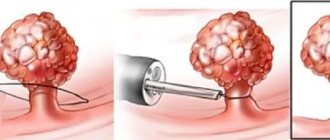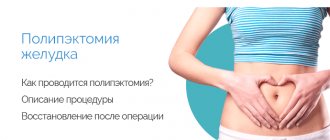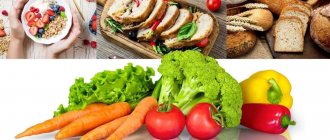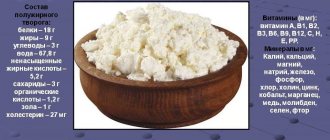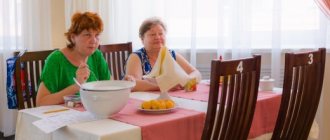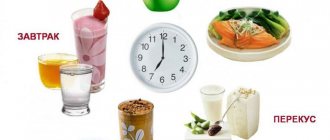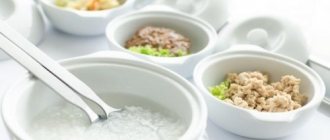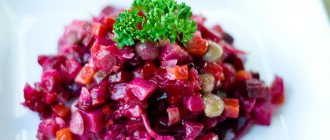The text is presented for informational purposes only. We strongly urge you not to self-medicate. When the first symptoms appear, consult a doctor. We recommend reading: “Why you can’t self-medicate?”
Polypectomy is the removal of tumors within the intestinal mucosa. After endoscopic surgery, the surface of the intestine remains damaged. These areas of the intestine are not protected and are easily injured when food passes through, so nutrition should be gentle.
Following a diet in the postoperative period accelerates the healing of the mucous membrane and prevents the development of complications.
Medical products (drugs, medicines, vitamins, dietary supplements) are mentioned for informational purposes only. We strongly do not recommend using them without a doctor's prescription. We recommend reading: “Why can’t you take medications without a doctor’s prescription?”
General rules
Polyposis of the intestinal tract is a relatively rare pathology, which is largely determined by mild and nonspecific clinical symptoms. Intestinal polyps are mainly detected during intestinal examinations using instrumental methods in patients complaining of discomfort in the anorectal area, abdominal pain, bloating , intestinal dysfunction ( constipation , diarrhea , flatulence ), pain in the anus, pathological discharge from the anus (clots and streaks of blood, mucus, scarlet blood).
The clinical picture is largely determined by the location and size of the polyps. About 75% of all single and multiple polypous neoplasms are located in the lower gastrointestinal tract, mainly in the sigmoid and rectum. Multiple polyps can be located compactly in one section of the large intestine or scattered in each section of the intestine. The main danger of intestinal polyposis is the high probability of their malignancy (malignant degeneration).
Surgical treatment of intestinal polyps is polypectomy . Conservative treatment methods are used only for diffuse polyposis of the entire gastrointestinal tract, as well as temporarily as symptomatic treatment in the preoperative period and in preparation for surgery. Removal of polyps is most often carried out by endoscopic methods - excision of the polyp by electrocoagulation of its base during colonoscopy (polyps in the large intestine) and sigmoidoscopy (for rectal polyps).
Diet for intestinal polyps is the most important component of conservative therapy in the preoperative period and, especially, after removal of polyps. Since polyps in the intestines are often manifested by intestinal dysfunction (constipation, diarrhea, flatulence), to relieve/reduce the severity of symptoms, appropriate dietary nutrition is prescribed - therapeutic Table No. 3 , No. 4 according to Pevzner. So, for colitis Diet No. 4 are prescribed , which is aimed at sparing the intestinal mucosa, reducing inflammation and normalizing digestion.
Therapeutic nutrition during an exacerbation (abdominal pain, diarrhea ) involves excluding from the diet foods that increase intestinal motility, cause fermentation/rotting and stimulate pancreatic secretion. The basic principles of nutrition are:
- Reduction in the diet of fats (up to 70 g) and carbohydrates (300 g) with the physiological norm of protein (90 g).
- Exclusion from the diet of foods containing fiber (rye/whole grain bread, vegetables, fruits).
- Small meals and a ban on solid/thick foods. The basis of nutrition consists of mucous pureed soups and semi-liquid/mushy dishes.
- Avoid very hot/cold foods.
- Limit salt to 8-10 g.
- Boiled (steam) culinary method of preparing dishes.
As the stool normalizes, unprocessed Diet 4B , which provides for expanding the diet by introducing chunks of meat, crumbly porridges, boiled raw vegetables, raw fruits, and cottage cheese. Subsequently, patients are transferred to the standard Diet No. 15 , which is initially prescribed in the form of loading days, and then on an ongoing basis.
If the patient has predominant constipation , we recommend treatment Table No. 3 , enriched with fiber (vegetables, bread with bran, vegetable juices, vinaigrettes). In this diet, it is necessary to take into account the effect of foods on the large intestine and the diet should contain foods that enhance peristalsis. These include products:
- Containing a lot of dietary fiber - wholemeal bread, bran, legumes, nuts, dried fruits, cereals (millet, barley, pearl barley, buckwheat, oatmeal), raw vegetables.
- Rich in easily digestible carbohydrates - jam, sugar, jam, syrups, honey.
- Contains a lot of organic acids - pickled/pickled vegetables, fermented milk drinks, sour fruits and juices from them.
- Containing salt - salted vegetables, fish, canned food.
- Fats (sour cream/cream, egg yolks) consumed in large quantities on an empty stomach (1-2 tbsp.).
- Meat containing connective tissue.
- Sweet drinks/mineral waters containing carbon dioxide.
- Prone to swelling - seaweed, fiber, bran.
- Cold dishes (150 C), consumed on an empty stomach - jellied meat, okroshka, cold jellied dishes, beetroot soup, ice cream.
The diet provides mechanical stimulation of intestinal motility and chemical sparing of the mucous membrane. Food is boiled or baked, or prepared in uncut form. Vegetables can be consumed both raw and boiled. Meals 4-6 times a day. The level of free fluid is at least 1.5 l/day, since when there is a lack of fluid, the intestinal mucosa absorbs fluid from the feces, giving additional hardness to their consistency.
Diet after removal of a polyp in the intestine is of particular importance. The diet after removal of polyps involves the appointment of surgical treatment Tables 0A , 0B , 0B , which provide the most gentle nutrition with fractional meals up to 6-8 times a day in small portions. The amount of table salt in the diet is limited. The daily amount of free fluid is 1-1.2 liters/day. Food with a liquid/semi-liquid consistency is allowed first, and then pureed foods.
On the first day after removal of polyps, the patient is shown a fasting regime and the patient should receive intravenous nutritional support. Drinking liquid is allowed 5-6 hours after anesthesia. Meals start with rice water, low-fat chicken broth, strained berry jelly/compotes. On the 3-4th day, the diet is expanded with cereal mucous soups, liquid pureed rice, buckwheat, oatmeal, boiled in water, soft-boiled eggs or in the form of a steamed protein omelet, pureed meat/fish, low-fat cream as an additive to ready-made dishes (up to 50 ml).
In the daily diet at this stage, the amount of basic food nutrients is: protein 50 g, fat 40 g, carbohydrates 250 g. On days 9-10 the patient is transferred to Diet 0B (80-90 g protein, 60-70 g fat, 300- 320 g of carbohydrates), the diet in which is expanded to include crackers from white bread (up to 100 g), pureed soups, pureed porridges, dishes from pureed dietary red meat, steamed chicken and fish, fermented milk drinks, pureed vegetables puree, pureed cottage cheese with cream, baked sour apples, tea with milk.
Approximately a month (depending on how you feel) after removal of polyps in the intestines, the patient is transferred to treatment Table 4B for a period of 5-6 months. The consumption of fatty broths, coarse vegetables, legumes, rye bread, pastry products, onions, garlic, celery, spinach, radishes, radishes, fatty meats, smoked meats, hot/fatty sauces, spices, solid animal fats, whole milk is prohibited. , millet, corn, pearl barley and barley, cakes, ice cream, chocolate, carbonated drinks, kvass, fruit drinks. To increase the cavity hydrolysis of food and normalize the processes of digestion and absorption, it is recommended to take enzyme preparations - Intestopan , Panzinorm , Abomin , Lipocaine .
After a few months, the patient is transferred to Treatment Table 4B , which contains a more expanded diet and is suitable for long-term/permanent use. In the absence of complaints and normal functioning of the intestines, the patient can be transferred to a common table, but with restrictions on foods that enhance the processes of fermentation/rotting in the intestines and spicy foods.
Cause of occurrence
Doctors insist that when going through the methods of treating a given disease, it would be more logical to first identify the original source of the problem. In the future, this will allow us to carefully work on prevention in order to block all chances of relapse.
In clinical practice, there is no one hundred percent correct factor that prompts the development of defects that are so painful for a person. Usually several aspects come together, including:
- disruptions in the psycho-emotional state;
- chronic inflammation of the intestinal mucosa;
- bad heredity;
- unfavorable environmental conditions;
- sedentary lifestyle with little physical activity.
But the most important point is still poor nutrition. When a person's daily diet does not include enough plant fiber, the rectum begins to protest. It bleeds, signaling that it is gradually becoming covered from the inside with destructive growths.
Some researchers adhere to the theory that the harbinger of polyps is chronic inflammatory processes localized in the colon. The following diseases also become indirect catalysts for failure in the body:
- enteritis;
- ulcerative colitis;
- dysentery;
- haemorrhoids.
Frequent constipation or any other disorders of the digestive system can provoke the development of pathology. Also, with reduced immune functions, the body turns into an optimal environment for pathogens of viral infections, which often have consequences in the form of effects on the rectum. The victim’s passion for food that contains a high amount of fat is taken into account separately. Drinking alcoholic beverages and smoking, as well as age-related changes, add risks.
Authorized Products
The basis of the diet after removal of polyps in the intestines is low-fat meat/fish broth and soups based on it with the addition of a small amount of pureed vegetables, egg flakes, pureed meat, or meatballs.
It is allowed to include pureed buckwheat, semolina and oatmeal, and rice (white) in the diet. All dishes are prepared by steaming or stewing. Butter is allowed to be added only to ready-made dishes (5g/serving). Dried wheat bread or white crackers (200 g/day). Dry cookies are allowed.
Lean varieties of veal, beef, chicken (without skin) or turkey are allowed. You can make meatballs or steam cutlets from minced meat. You can add boiled white rice to the cutlets/meatballs. Soft-boiled eggs or in the form of a steam omelet are allowed, up to two eggs per day. Sea fish of low-fat varieties, prepared in the form of cutlets and meatballs or in pieces.
It is allowed to include unleavened (non-acidic) freshly prepared calcined cottage cheese in mashed form into the diet. Vegetables are used only as an additive to soups. Mashed apples/applesauce are allowed in their raw form. You can prepare berry decoctions, jelly and fruit drinks from berries (blackcurrant, blueberry, dogwood, quince, pear).
It is allowed to include fresh juices from sweet berries diluted with water in the diet. As a liquid, it is recommended to use herbal tea, rosehip decoction, still water, green/black tea.
Table of permitted products
| Proteins, g | Fats, g | Carbohydrates, g | Calories, kcal | |
Vegetables and greens | ||||
| zucchini | 0,6 | 0,3 | 4,6 | 24 |
| tomatoes | 0,6 | 0,2 | 4,2 | 20 |
| pumpkin | 1,3 | 0,3 | 7,7 | 28 |
Fruits | ||||
| apricots | 0,9 | 0,1 | 10,8 | 41 |
| quince | 0,6 | 0,5 | 9,8 | 40 |
| bananas | 1,5 | 0,2 | 21,8 | 95 |
| pears | 0,4 | 0,3 | 10,9 | 42 |
| dogwood | 1,0 | 0,0 | 10,5 | 44 |
| apples | 0,4 | 0,4 | 9,8 | 47 |
Berries | ||||
| blackberry | 2,0 | 0,0 | 6,4 | 31 |
| blueberry | 1,1 | 0,4 | 7,6 | 44 |
Nuts and dried fruits | ||||
| dried pears | 2,3 | 0,6 | 62,6 | 249 |
| dried blueberries | 0,9 | 0,7 | 72,3 | 309 |
Cereals and porridges | ||||
| buckwheat (kernel) | 12,6 | 3,3 | 62,1 | 313 |
| semolina | 10,3 | 1,0 | 73,3 | 328 |
| oat groats | 12,3 | 6,1 | 59,5 | 342 |
| cereals | 11,9 | 7,2 | 69,3 | 366 |
| white rice | 6,7 | 0,7 | 78,9 | 344 |
Bakery products | ||||
| white bread crackers | 11,2 | 1,4 | 72,2 | 331 |
| doctor's bread | 8,2 | 2,6 | 46,3 | 242 |
Confectionery | ||||
| jam | 0,3 | 0,2 | 63,0 | 263 |
| jelly | 2,7 | 0,0 | 17,9 | 79 |
| marshmallows | 0,8 | 0,0 | 78,5 | 304 |
| fruit and berry marmalade | 0,4 | 0,0 | 76,6 | 293 |
| paste | 0,5 | 0,0 | 80,8 | 310 |
| oatmeal cookies | 6,5 | 14,4 | 71,8 | 437 |
Raw materials and seasonings | ||||
| honey | 0,8 | 0,0 | 81,5 | 329 |
| sugar | 0,0 | 0,0 | 99,7 | 398 |
| dried bird cherry | 8,4 | 0,0 | 16,8 | 101 |
Dairy | ||||
| acidophilus | 2,8 | 3,2 | 3,8 | 57 |
Cheeses and cottage cheese | ||||
| cottage cheese 0.6% (low fat) | 18,0 | 0,6 | 1,8 | 88 |
Meat products | ||||
| boiled beef | 25,8 | 16,8 | 0,0 | 254 |
| boiled veal | 30,7 | 0,9 | 0,0 | 131 |
| rabbit | 21,0 | 8,0 | 0,0 | 156 |
Bird | ||||
| boiled chicken | 25,2 | 7,4 | 0,0 | 170 |
| turkey | 19,2 | 0,7 | 0,0 | 84 |
Fish and seafood | ||||
| herring | 16,3 | 10,7 | — | 161 |
Oils and fats | ||||
| butter | 0,5 | 82,5 | 0,8 | 748 |
| corn oil | 0,0 | 99,9 | 0,0 | 899 |
| olive oil | 0,0 | 99,8 | 0,0 | 898 |
| sunflower oil | 0,0 | 99,9 | 0,0 | 899 |
Non-alcoholic drinks | ||||
| mineral water | 0,0 | 0,0 | 0,0 | — |
| green tea | 0,0 | 0,0 | 0,0 | — |
Juices and compotes | ||||
| carrot juice | 1,1 | 0,1 | 6,4 | 28 |
| tomato juice | 1,1 | 0,2 | 3,8 | 21 |
| rose hip juice | 0,1 | 0,0 | 17,6 | 70 |
| * data is per 100 g of product | ||||
The right preparatory approach
Before finally choosing the mode of excision of the lesion, the proctologist is obliged to send his ward to undergo a preliminary examination. It is aimed at eliminating contraindications. Some diagnostic measures make it possible to qualitatively visualize polyps in order to assess their number, size, and characteristics.
Typically, preparation includes digital examination of the rectum. But since this is often not enough, the doctor issues a referral for an endoscopic examination of the colon. We are talking about sigmoidoscopy and colonoscopy.
It cannot be done without histological examination of the biopsy material. The procedure is aimed at eliminating the possibility of an ordinary benign tumor degenerating into a malignant one.
If the information picture is insufficiently complete, irrigoscopy may be used. But gastroscopy is prescribed to almost everyone without exception. An endoscopic examination is designed to examine the health of the upper gastrointestinal tract.
Differential diagnosis allows you to distinguish a polyp from pathologies with similar external signs. Sometimes they can peacefully coexist in the same intestine, which significantly complicates treatment.
Most often, a classic polyp is confused with an early stage lipoma, which is localized in the submucosal layer of the right side of the colon. But as soon as it grows to an impressive size, it blocks the entire path.
It is a little more difficult to confuse the pathology with a tumor of non-epithelial size, since the latter does not have a special distinctive stalk. Also included in the list of similar ailments are large fibroids that grow in the muscle layer, angiomas, vascular tumors, and actinomycosis.
Crohn's disease is especially insidious, which is often diagnosed under the concept of pseudopolyposis. In fact, the focus of this disease is located much higher - in the upper part of the large intestine.
To determine a specific disease, as well as to minimize the chances of mixing several anomalies at once, a histological test is performed.
Fully or partially limited products
In the diet after removal of polyps in the intestines, foods containing a lot of coarse fiber are completely excluded: bran, vegetables, rye/whole grain bread, since they are poorly digested and injure the intestinal mucosa. It is not allowed to eat flour products, fresh bread, pastries, jam, dried fruits, sweets, as they cause fermentation in the intestines.
Fatty rich broths, fatty meats, fatty fish, any sausages, waterfowl meat, canned food, solid animal fats/cooking fats are prohibited in the diet. During the period of exacerbation, the consumption of porridges made from coarse cereals (pearl barley, barley, millet), legumes, vegetables and pasta is not allowed.
Hard-boiled and fried eggs, soups with vegetables, whole grains and pasta, whole milk, fatty sauces, spicy, salty cheeses, margarine, smoked meats, mustard, horseradish, pepper, chocolate, cakes, ice cream are excluded from the diet.
Drinks such as coffee/cocoa with milk, carbonated drinks, and alcohol are not allowed.
Table of prohibited products
| Proteins, g | Fats, g | Carbohydrates, g | Calories, kcal | |
Vegetables and greens | ||||
| vegetables | 2,5 | 0,3 | 7,0 | 35 |
| vegetables legumes | 9,1 | 1,6 | 27,0 | 168 |
| canned vegetables | 1,5 | 0,2 | 5,5 | 30 |
| swede | 1,2 | 0,1 | 7,7 | 37 |
| parsnip | 1,4 | 0,5 | 9,2 | 47 |
| parsley (root) | 1,5 | 0,6 | 10,1 | 49 |
| radish | 1,2 | 0,1 | 3,4 | 19 |
| turnip | 1,5 | 0,1 | 6,2 | 30 |
| celery | 0,9 | 0,1 | 2,1 | 12 |
| horseradish | 3,2 | 0,4 | 10,5 | 56 |
| garlic | 6,5 | 0,5 | 29,9 | 143 |
| spinach | 2,9 | 0,3 | 2,0 | 22 |
| sorrel | 1,5 | 0,3 | 2,9 | 19 |
Fruits | ||||
| melon | 0,6 | 0,3 | 7,4 | 33 |
Berries | ||||
| grape | 0,6 | 0,2 | 16,8 | 65 |
Mushrooms | ||||
| mushrooms | 3,5 | 2,0 | 2,5 | 30 |
Nuts and dried fruits | ||||
| dried fruits | 2,3 | 0,6 | 68,2 | 286 |
Cereals and porridges | ||||
| pearl barley | 9,3 | 1,1 | 73,7 | 320 |
| Wheat groats | 11,5 | 1,3 | 62,0 | 316 |
| millet cereal | 11,5 | 3,3 | 69,3 | 348 |
| barley grits | 10,4 | 1,3 | 66,3 | 324 |
Flour and pasta | ||||
| pasta | 10,4 | 1,1 | 69,7 | 337 |
Bakery products | ||||
| Rye bread | 6,6 | 1,2 | 34,2 | 165 |
Confectionery | ||||
| jam | 0,3 | 0,1 | 56,0 | 238 |
| candies | 4,3 | 19,8 | 67,5 | 453 |
| pastry cream | 0,2 | 26,0 | 16,5 | 300 |
| cookie | 7,5 | 11,8 | 74,9 | 417 |
| shortbread dough | 6,5 | 21,6 | 49,9 | 403 |
Ice cream | ||||
| ice cream | 3,7 | 6,9 | 22,1 | 189 |
Cakes | ||||
| cake | 4,4 | 23,4 | 45,2 | 407 |
Chocolate | ||||
| chocolate | 5,4 | 35,3 | 56,5 | 544 |
Raw materials and seasonings | ||||
| seasonings | 7,0 | 1,9 | 26,0 | 149 |
| mustard | 5,7 | 6,4 | 22,0 | 162 |
| ketchup | 1,8 | 1,0 | 22,2 | 93 |
| mayonnaise | 2,4 | 67,0 | 3,9 | 627 |
Dairy | ||||
| milk | 3,2 | 3,6 | 4,8 | 64 |
| kefir | 3,4 | 2,0 | 4,7 | 51 |
| sour cream | 2,8 | 20,0 | 3,2 | 206 |
Cheeses and cottage cheese | ||||
| cheese | 24,1 | 29,5 | 0,3 | 363 |
Meat products | ||||
| pork | 16,0 | 21,6 | 0,0 | 259 |
| ham | 22,6 | 20,9 | 0,0 | 279 |
Sausages | ||||
| dry-cured sausage | 24,1 | 38,3 | 1,0 | 455 |
| sausages | 10,1 | 31,6 | 1,9 | 332 |
| sausages | 12,3 | 25,3 | 0,0 | 277 |
Bird | ||||
| duck | 16,5 | 61,2 | 0,0 | 346 |
| goose | 16,1 | 33,3 | 0,0 | 364 |
Fish and seafood | ||||
| dried fish | 17,5 | 4,6 | 0,0 | 139 |
| smoked fish | 26,8 | 9,9 | 0,0 | 196 |
| canned fish | 17,5 | 2,0 | 0,0 | 88 |
Oils and fats | ||||
| vegetable oil | 0,0 | 99,0 | 0,0 | 899 |
| animal fat | 0,0 | 99,7 | 0,0 | 897 |
| cooking fat | 0,0 | 99,7 | 0,0 | 897 |
Non-alcoholic drinks | ||||
| bread kvass | 0,2 | 0,0 | 5,2 | 27 |
| coffee with milk and sugar | 0,7 | 1,0 | 11,2 | 58 |
| * data is per 100 g of product | ||||
Dish recipes
The range of permitted products is characterized by diversity. Therefore, there will be no problems with creating a diet menu. The same ingredients can be cut into small cubes or strips, and different heat treatments can be used. The end result is completely different dishes.
Stew without meat
First you need to prepare all the vegetables: potatoes, zucchini, onions, corn, sweet peppers, carrots. All ingredients (except corn) are cleaned and crushed. Whether it's cubes or straws, it doesn't matter. Potatoes and carrots are simmered in vegetable oil in a pot for 2-3 minutes, after which the vegetables are poured with water. 10 minutes after boiling, add the remaining ingredients. The water should cover the contents of the pan. Simmer for another 10-15 minutes. At the end, the dish is salted and sprinkled with fresh herbs.
Stew with meat
It is better to prepare this dish in a slow cooker or oven. Vegetables cut into strips (potatoes, eggplants, carrots and bell peppers) are poured with boiling water and kept for 15 minutes under a closed lid. At this time, the poultry meat is cut into cubes and simmered in a frying pan in vegetable oil for about 10 minutes. Combine all ingredients in a baking dish or multicooker bowl. Salt the workpiece and pour in a sauce made from sour cream and water (take 2 tablespoons of sour cream per 200 ml of liquid). Simmer until done (30-45 minutes).
Ear
Pour water into a saucepan and place it on the fire. Before boiling, add diced vegetables:
- potato;
- carrot;
- onion;
- Bell pepper.
After 15 minutes, place a gauze bag containing pieces of perch or carp into a boiling container. You can use assorted fish; dietary principles are not violated by such variety. After 20 minutes, add some salt to the fish soup and remove from the heat. The final touch is chopped greens. It is added to the pan or directly into the bowl.
Vegetable soup
Prepared without meat or with (low-fat) broth. Add diced vegetables to a saucepan with boiling liquid:
- potato;
- carrot;
- onion;
- broccoli.
After the vegetables become soft, remove the pan from the heat and enrich the soup with fresh herbs (dill, parsley).
Tilapia fillet
Rinse the fish and dry with a napkin. Add a little salt and roll in breadcrumbs. Place the fillet on foil and pour a sauce of olive oil (a few drops) and lemon juice (1 tsp). Bake in foil, setting the oven temperature to 180°. After 15 minutes, open the foil, brush the top of the fish with sour cream and leave to bake for another 5 minutes. When serving, the dish is sprinkled with fresh herbs.
Steamed cutlets
Grind veal (300 g) in a meat grinder using a fine sieve. Add to minced meat:
- salt (1/2 tsp without a slide);
- sour cream (1 tbsp);
- egg (1 pc.);
- chopped greens (dill, cilantro, green onions).
Mix the resulting mass and form into cutlets. Place the pieces on the steamer stand. Leave covered for 25 minutes.
Oatmeal jelly
Oatmeal flakes (200 g) are poured with water (500-600 ml) and left in the container for 20-24 hours. If signs of fermentation are detected, you can continue preparing the drink. The fermented product is passed through a sieve. The flakes are thrown away, the liquid is slightly salted and sugar is added (1.5 tbsp). Cook over moderate heat with constant stirring until boiling. As soon as the bubbles appear, the jelly is removed and poured into cups.
Reviews and results
According to patient reviews, therapeutic nutrition after removal of polyps in the intestines has a positive effect on its functions: stools are normalized, pain is reduced, and rumbling and bloating in the intestines are eliminated.
- “... After the removal of the sigmoid colon polyp, I am on a diet. In the first postoperative month, the diet was very strict, but now, after 6 months, the diet is almost approaching normal nutrition. I cook almost all dishes in a slow cooker, I have mastered it well and have adapted to preparing many delicious dishes. While on the diet, stool almost returned to normal, mucus and blood disappeared. I am gradually expanding my diet - increasing the volume of pureed vegetables, vegetable oil and the amount of sugar. I’m just very worried about the possible appearance of new polyps, since the doctor said that such a danger exists”;
- “... During a random colonoscopy examination, a single polyp measuring 6 mm was discovered in the large intestine. They took a histology analysis. Diagnosis: tubular adenoma of the sigmoid colon with grade 1 dysplasia. They suggested surgery. I agreed. Everything went fine. He endured the postoperative period well. Now I'm on a diet. The doctor said that you need to follow the diet for at least six months. Fortunately, the diet is not so strict, you can live normally.”
Preparing to remove rectal polyps
Before removal of rectal polyps, patients are advised to follow a special diet that excludes fiber-rich foods to reduce intestinal volume. The day before the treatment, it is recommended to drink more water and use a cleansing enema to completely cleanse the intestines of feces. Your doctor may also recommend taking laxatives. To do this, you can use regular enemas, or special medicinal ones: Microlax, Enema wedge. Sometimes, to completely cleanse the colon, the doctor may recommend taking special laxatives - Fortrans, Lavacol, Endofalk.
Freedom from diet
The postoperative period ends, the doctor prescribes control tests and diagnostic examinations to the patient. If, according to the results of the analysis, the patient shows stable positive dynamics, there are no signs of relapse of the disease, the doctor allows him to switch to a normal diet.
Remember, diet number 10 should not be abandoned abruptly. The introduction of new products is gradual. Heavy foods and foods high in calories are introduced with caution, listening to the body's reaction to it.
You can start the transition by including milk and a small piece of butter in your morning portion of porridge. If there is no deterioration in your health after the product is introduced, then you can try introducing the next ingredient. For example, try eating a piece of cheese or cooking pork soup.
If you experience bloating, problems with stool, heartburn or a feeling of heaviness, it is better to return to a gentle menu and consult a doctor about the possible causes of deterioration in well-being. He will offer competent tactics.
General recommendations for nutrition after recovery
When the critical period has passed, the doctor makes a favorable prognosis for recovery; the stomach must still be spared. The introduction of new foods when switching to a normal diet is perceived normally by the intestines, and the patient is considered to be healthy. However, doctors recommend adhering to the rules throughout the rest of your life:
- Reduce the amount of salt. Doctors have proven the negative effect of salt on the body’s vital functions. The seasoning interferes with blood circulation.
- Sour and hot spices should be avoided.
- Fractional and separate meals are a good alternative to lifelong diets. This diet does not burden the gastrointestinal tract and helps normalize metabolism.
- It is recommended to replace high-mountain tea and cocoa with herbal drinks. Drinks made from a mixture of herbs are healthier.
Organization of proper nutrition is not able to eliminate existing pathogenic neoplasms. However, this prevents the progression of pathology and performs a strengthening function, preventing the risk of damage to polyps by hard pieces of food. A diet after a colonoscopy can be recommended to the patient for a long time; it prevents the re-formation of growths in the intestines.
